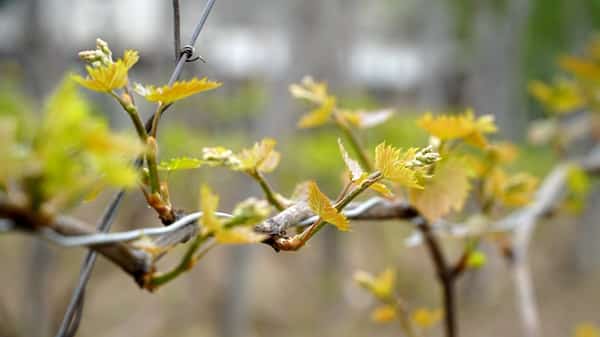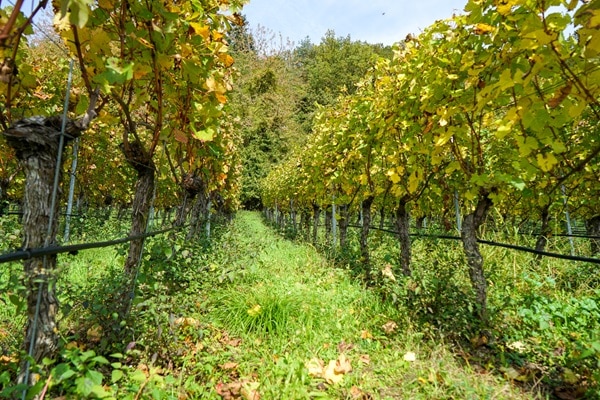The vine, the emblem of French viticulture, owes its longevity and diversity to an ancestral practice: grafting. This crucial technique consists in combining two distinct parts: the rootstock, the root system, and the scion, the aerial part from a noble grape variety, Vitis vinifera, which gives the vine its gustatory qualities.
Grafting is an essential stage in the production of vine plants. It combines the advantages of the rootstock, such as resistance to soil-borne diseases and vigor, with the qualitative characteristics of the graft, such as grape finesse and aroma typicity.
Mastering the various grafting techniques, such as split grafting, omega grafting or grafting on, is a precious skill for winegrowers. This meticulous practice guarantees not only the production of healthy, vigorous plants, but also the preservation of noble grape varieties and the diversity of France’s winegrowing heritage.
The different types of vine grafting
Mastering grafting techniques is crucial to the health and productivity of our vines. Grafting a vine is a delicate but essential practice for producing robust, resilient plants, especially in the face of the challenges posed by vine diseases such as phylloxera.

Cleft grafting
Slot grafting is one of the most common and effective techniques. It involves making a slit in the trunk of the rootstock and inserting the graft. Here’s how it’s done:
- Preparation: prune the rootstock and make a vertical slit about 3-5 cm deep in the wood.
- Insertion: prepare the graft with a bevel cut to fit the slot. Insert the graft into the slot, ensuring that the cambiums of both parts are aligned.
- Fixing: secure the graft with material such as plastic ligatures and cover with putty to prevent sap loss and dehydration.
Bud graft or eye graft
This method is ideal for grafting specific varieties onto younger rootstocks or when you want to add different grape varieties. Here are the steps:
- Preparation: choose a graft with one eye (or bud) and make a T-cut on the rootstock trunk.
- Insertion: insert the eye under the bark, making sure it makes good contact with the cambium.
- Fixation: wrap the graft area with specific material to protect against infection and promote adhesion.
Omega graft
Omega grafting is a more sophisticated technique that allows for greater precision in the alignment of the cambiums.
- Preparation: prune the rootstock and scion into an “omega” shape, with a curved cut.
- Insertion: insert the graft into the rootstock, ensuring that the cutting surfaces are perfectly aligned.
- Fixation: use ligatures or clips to hold the graft in place, and cover the graft with putty to protect against disease.
The best times to graft a vine
The two best periods for grafting a vine are spring and autumn, each offering unique advantages for the success of your grafts.
Spring: the renewal of sap
Spring is often considered the ideal time for grafting. During this season, sap begins to circulate actively in the vines, promoting rapid healing and good integration of the grafts. This is the time when the vine, emerging from its winter dormancy, is full of energy to welcome new grafts. This period is particularly favourable for wood grafts and grafting techniques, as the vine is ready to concentrate on growth and repair.

Autumn: the serenity of dormancy
Autumn offers a different but equally effective approach. When vines go dormant, the risk of dehydration is considerably reduced. Grafting in autumn can give the grafts a chance to stabilize before the cold returns. At this time of year, grape varieties are ready to prepare for the coming year, and the still-warm soil makes it easier for the grafts to establish themselves. This period is ideal for grafting operations in nurseries, and allows the plants to take advantage of the months of rest to acclimatize to the new conditions.
Choice and practice: the keys to success
Whether you choose to graft in spring or autumn, there are a number of factors to consider to ensure the success of your grafts. Make sure your grafting equipment is of the highest quality, and carefully select grape varieties and techniques according to your soil and local climatic conditions. Regular maintenance, including adequate watering and protection against phylloxera, is crucial to the good health of grafts and vines.
Choosing rootstock and scion

The rootstock is the part of the plant that provides the root system, while the scion is the upper part that will produce the desired grape variety. The choice of these components depends on several factors:
- Soil type: rootstocks such as Fercal or Gravesac are more resistant to certain types of soil. For example, limestone soils favor certain rootstocks, while others are better adapted to clay or sandy soils.
- Disease resistance: some rootstocks are resistant to phylloxera, which is crucial for the health of your vines.
- Adaptation to climatic conditions: some rootstocks are more tolerant of extreme weather conditions or temperature variations.
The graft should be chosen according to the quality of the desired grape variety and its compatibility with the rootstock. Grape varieties adapted to your region and soil type will be more productive. You should also consider
- Production potential: make sure the graft you choose has a good yield in terms of quality and quantity.
- Organoleptic characteristics: choose grafts that produce the aromatic profile you want for your wines.
Vineyard maintenance and post-grafting care
Once you’ve grafted your vines, whether by cleft or top grafting, there are a few key steps to follow to ensure that your work bears fruit.
1- Keep an eye on your grafts
Once you’ve grafted the scions onto the rootstock, it’s crucial to check their condition regularly. Make sure the grafts have taken well. Look to see if the graft and rootstock are well fused. If you see any signs of detachment, it may be necessary to re-secure the grafts with ties.
2- Manage watering with precision
The young plants need special care in terms ofwater :
- Watering: water your vines regularly, but avoid drowning them. The idea is to keep the soil sufficiently moist for the plants to take root, without encouraging diseases linked to excesswater.
- Drainage: check that the soil is well drained. Soil that is too compact can hinder root growth.
3- Protect your vines
In periods of intense cold, young vines and grafts are also vulnerable to sub-zero temperatures, which can cause significant damage. Using an anti-freeze device to protect your vines in winter can indeed be an effective solution to prevent frost damage.
4- Prune and shape your vines
Proper pruning and training are essential:
- Pruning vines: practice pruning to encourage good growth. Do not cut too close to the grafting to avoid damaging the new part of the plant.
- Training: guide young plants to develop properly. This will help form a strong trunk and robust vine structure.
Take the time to master this practice and care for it, and you’ll be rewarded with rich, tasty harvests for years to come.

